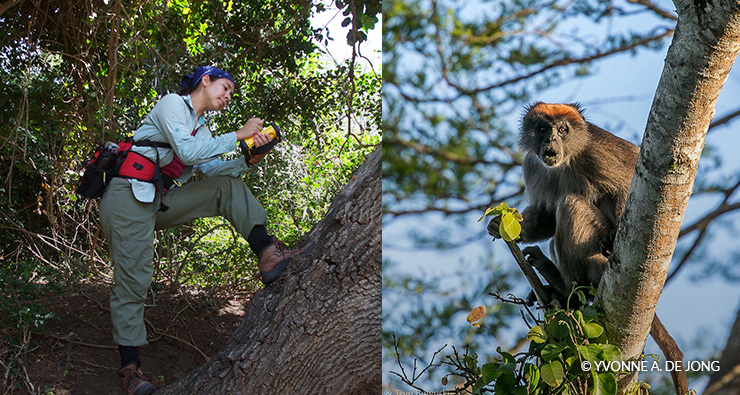Safeguarding Biodiversity With GIS
SSI’s Laura Loyola is working to protect an endangered Kenyan primate
Deep in the gallery forests of southeastern Kenya, fewer than 1,000 primates known as the Tana River red colobus (Piliocolobus rufomitratus) remain. Flooding, fires, agricultural practices, selective logging and unsustainable wood collection are dramatically eroding the red colobus species forest habitat, imperiling its survival. As a result, the International Union for the Conservation of Nature (IUCN) now considers this species to be critically endangered and one of the world’s 25 most threatened primates.
But Dr. Laura Loyola of the USC Spatial Sciences Institute is trying to save the red colobus primates from extinction.
Loyola, a co-author of the Tana River red colobus entry in the IUCN’s Red List of Threatened Species and of the Africa-wide Red Colobus Action Plan (ReCAP), uses geographic information science (GIS), remote sensing techniques and spatio-temporal analyses to connect the species behavior, their metabolizable energy, and the quality of their habitat to determine the most effective ways to conserve their wildlife habitat.
“The Tana River red colobus is only found in about 34 riverine and flood-plain forests along a 60-kilometer area of the lower Tana River and in the upper Tana Delta,” explains Loyola. “These forest habitats are also prime locations for agricultural production and have been sustainably utilized through traditional practices. However, the ever-growing population, prolonged drought years, changing and unpredictable flooding regime of the Tana River, and the political instability in neighboring Somali are anthropogenic pressures on forest health that are negatively affecting the already limited habitat of the red colobus,” she added.
Dr. Loyola also understands the importance of inclusivity and stakeholder buy-in for all conservation and management practices. She has helped conduct participatory workshops in surrounding villages to understand the varying local practices and engage community members in planning management strategies. She also works closely with organizations that train local villagers to work as forest rangers and researchers, enabling them to become financially stable while working to protect forest environments.
The Tana River habitat has had allure for Loyola since her early years as a Ph.D. student in USC’s Integrative and Evolutionary Biology doctoral program. She was interested in geographic variations in species distribution and in behavioral as well as physiological species assessment. Her first opportunity to work in the Tana River habitat was in the summer of 2011, when she participated in field work that was oriented to community development and sustainability.
Loyola recalls, “Because the red colobus are canopy dwelling, they are quite difficult to study and there hadn’t been any previous research done on their behavior. And as the site is quite remote and desolate, there weren’t any other western researchers there at that time.” Buoyed by the welcoming and helpful support of the Kenya Wildlife Services and Kenyan project field assistants, Loyola thrived on the opportunity to delve into a pioneering research area and discovered her research passion.
With the integrative approach of the Red Colobus Conservation Action Plan, Loyola intends that her continuing work at the intersection of evolutionary biology, spatial sciences and sustainability will have a positive impact in building and implementing site-based activities that will pull the red colobus monkeys back from the brink of extinction. Read more about the Red Colobus Conservation Action Plan Initiative and about how the faculty and students of the Spatial Sciences Institute are using geography, GIS and spatial sciences to change the world.




